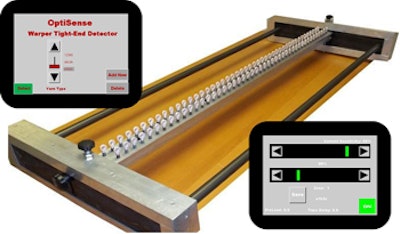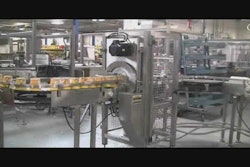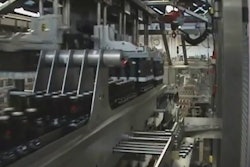
Winston-Salem, N.C.-based Essex Incorporated (Essex) is one of the nation's leading providers of manufacturing equipment for the textile industry. For more than three decades, the company has produced yarn break detectors, tight-end detectors, monitoring systems, backing tension control systems, and backing positioning systems.
Recently, the company's introduction of Opti-Sense technology has been a breakthrough in detecting yarn breaking and tight ends. Here's how it works: a textile warper winds up to 1,500 strands (i.e., ends) of yarn on a spool called a beam. The winding machine is called a warper. If a strand of yarn breaks and is wrapped up in the beam, it causes significant down time for the operator while they locate the broken end and rethread the machine.
"Normally we used a contact strip in tight end detection, but a customer came to us with a much tighter set of tolerances than we had seen before that required a much more sensitive contact strip," says David R. Parker, director of manufacturing at Essex. "Unfortunately, we couldn't find one."
A New Approach
Since Essex had worked extensively with Omron fiber optics, it explored the use of this technology as an alternative approach to the problem. "We needed a way to transmit light that would allow very sensitive changes in the incident light level," says Parker. (Fiber optic amplifiers display a number that is the incident light level, which is what the amplifier is sending out and receiving back. It's an arbitrary number.) "We've been able to shine that light through a piece of proprietary tubing; by manipulating the software, we're able to both monitor and change the set point at which the amplifier sends out a signal that indicates it has detected a defect."
In the warper, a ceramic eyelet presses down on the proprietary tubing, thereby lowering the light level-less light can get through the tubing, which lowers the incident number. When the incident light level drops below the set point, the amplifier sends out a signal that turns off the warper.
"Warpers move fast-several hundred feet per minute," notes Parker. "No one else in the industry has been able to come up with a solution that is fast enough to catch the defect before it gets wound into the beam. Opti-Sense can do that."
The Opti-Sense system detects when the yarn starts to pull tight, and allows the user to set the sensitivity via a touchscreen to whatever level is needed. "It can be set sensitive enough that you can almost blow on it and make it work," says Parker. When broken yarn gets wound up into a beam, operators have to back up, try to find the end, and then tie it back in. Opti-Sense is fast enough to catch the breakage and stop the machine before the yarn gets wound up into the beam. This saves time and money while helping to ensure product quality.
A Fit Times Two
Essex currently has two applications using Opti-Sense technology: for yarn breakage detection on warpers as described above and for standard tufting machine tight end detectors.
On tufting machines, the Opti-Sense system also takes the place of standard contact strips. "In a standard contact strip system, when the yarn pulls tight, it makes a 'tape switch' and shuts the machine off," explains Parker. "But we're using the same Opti-Sense technology in place of the contact strip, and we've found that it reacts significantly faster."
Frequently, when there is a tight end on standard tufting machines, the pile height on the carpet changes just a little bit. You can't see it with the naked eye until it's been run through a dye bath, when it pops right up and is easily identified. But by that time yards of carpet have been run that have to be scrapped or sold as reduced quality goods.
The sensitivity of the Opti-Sense system enables tight ends to be caught before this happens. "Let's say you have an incident light level of 2,500," says Parker. "If you set it for 1,000, it's not going to be very sensitive, because that number is going to have to be lowered to below 1,000 before it reacts. But if you have an incident light level of 2,500, and set if for 2,498, you can see the defect situation very quickly and avoid the risk that comes with running product in that instance."
Why Omron?
According to Parker, Essex has been using Omron exclusively since 2003. "Omron's E3X-DA6P is the only fiber optic amplifier that allows you to monitor incident light level and transmit those numbers to a PLC," says Parker. "The PLC we selected, Omron's CP1L, is the only one we have found that allows us to communicate both with the amplifier and the touchscreen we are using as an HMI."
Parker describes the experience of working with Omron as "terrific," citing both customer service and account management as highly responsive in meeting Essex's needs.


























